Silicon Valley electronic advertizing screen
This is an essay of a weary traveler about modern hi-tech advertising on large electronic screens. But first I must pay tribute to California, a place that I love the most. I visit California every half a year and can observe all gradual but inevitable changes. This is one of the richest geographical regions on earth with high population density. Third in size after Texas and Alaska, it stretches 1100 miles from South to North and 300 miles from West to East.
California boasts a well-developed road network and beautiful 101 Highway that connects San Francisco and Los Angeles. South of San Francisco along the 101 Highway is the famous Silicon Valley. Geographically, Silicon Valley is an area of Northern California that contains a thirty-mile by ten-mile strip of land in Santa Clara County between the cities of San Francisco and San Jose.
This economic region begins in the Northwest of the Valley in Palo Alto, where the bulk of theoretical and practical technological research in the area occurs at the Stanford University and the Stanford University Research Park. Silicon Valley is separated from the Pacific by the Russian mountain ridge that stops cold ocean winds and fogs. Cold Californian upwelling, rising of cold deep water levels, helps to maintain constant temperatures and contributes to rich oceanic life.
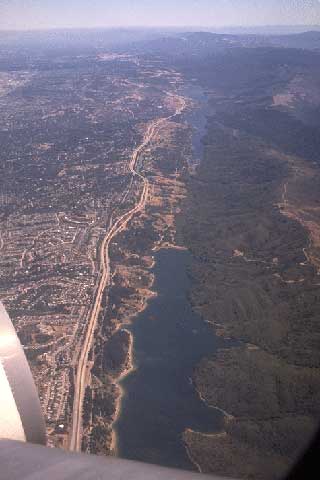 |
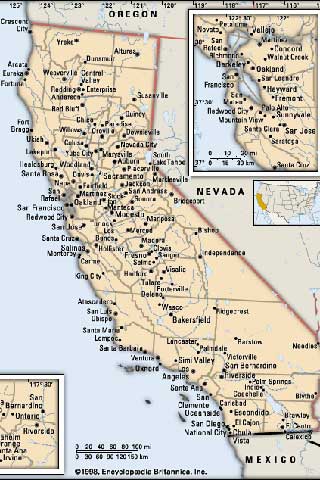 |
| Air view of the mountain ridge that is a natural boundary of Silicon Valley | Map of California, the Golden State of the USA |
The resulting mild weather allows Californians to joke that they live in a +25°C climate. Every joke has a grain of truth. People in this area are well-educated and the educational level is rising. Apart from Stanford and California Universities in Berkley, this area has many colleges. Moreover, the new immigrants (app. 150,000 annually) are very well-educated since they are planning to get employment in the electronics industry.
People with simple occupations can afford to live in Silicon Valley no longer due to high rents. Thus, the townships gradually turn into “settlements for millionaires”. For many reasons this area has more millionaires per square mile than anywhere else in the USA. Stanford is a breeding ground of hi-tech companies, such as multi-billion dollar Hewlett-Packard or Sun. All this affects the style of advertising.
 |
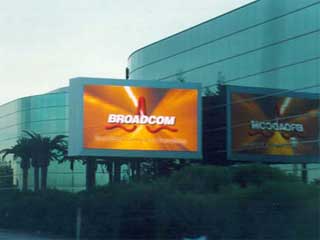 |
| ABC Headquarters media façade LED screen | Silicon Valley electronic advertizing screen |
Last year slogan of Apple is a good example: The words “Think different” on the background of some elderly guy in jeans. Those who follow the news know that this was the well-known physicist and Nobel-prize winner Feynman, popular for his textbooks on physics. This advertising is only good for Silicon Valley. Elsewhere, especially in other countries, such ad would have no effect: the living standards are much lower, and then who would recognize “Feynman”.
In my previous essay based on my New York impressions I tried to describe how electronic advertizing screens are being used in the USA.
Surprisingly, all electronic advertizing screens were company-owned and devoted their screening time exclusively to promoting their own companies. None of the electronic screens sold advertising time and displayed commercials of any outside companies. It’s great if your company owns an office on the Times Square, but what if your headquarters is located in some backwater county. But that was nearly one year ago! Much has changed since then.
Here I should write more about the model of Californian business. Unlike office buildings in New York that are competing in height and architectural beauty, the offices of most hi-tech Californian giants are located in simplistic-looking concrete sheds tangled in electricity lines and optical cables. The main asset of hi-tech companies is their personnel and corporate knowledge. The “new economics” created a new architectural approach to office buildings. This is how the office buildings of Exide, Sun and others look like. Naturally, nobody would go out of their way to visit such “poor” offices. The solution was obvious but was not used only until recently.
All offices of multi-nationals and all townships are linked by highways. The main 101 Route and 280 running parallel to it border Silicon Valley on the East and West. No matter where you go, you are bound to take either of these two. That’s why it was logical to install an electronic advertizing screen along the highway. 101 Route was chosen for heavier traffic.
Functionally, the Silicon Valley advertizing screen is different from those used in New York. It has become a board that simply sells time. The LED screen was placed halfway between San Francisco and San Jose. It has very large dimension of 9x12 meters. The image is very bright, color-saturated and smooth. Visually, the quality is no worse than on Sony-manufactured LED screen for the ABC HQ on Times Square in New York (see photo).
The Californian advertizing screen is made up of two screens facing different traffic flows. Such V design is a composite solution that allows to cover the audience on both sides of the highway. A similar installation was once operating in the very center of Moscow, Russia.
Drivers notice this advertizing screen from a long distance. It attracts all attention; all other nearby outdoor advertising boards simply disappear. There are so many boards along roads and highways that people hardly notice them anymore. Who remembers advertising on any of the boards once he returned home from work?
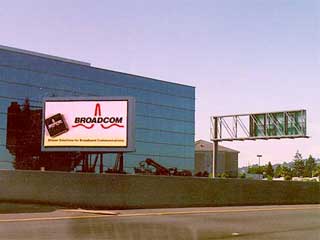 |
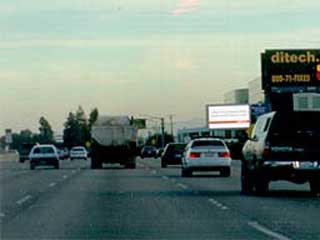 |
| South-to-North view. The LED screen is bright enough to operate during daytime facing direct sunshine. | Driving South in the evening. The LED screen is the brightest object around, impossible not to see. |
An electronic screen is different in this respect. It combines brightness, image clarity and constant change of pictures. It draws your attention from a long distance, people start looking at it long before they can distinguish the image details. This is how human brain and sight works: we are attracted to anything that moves.
The eye structure determines that a sharp image on the retina is located in the central part of the eye. Thus, everything that did not cause interest and did not result in subconscious focusing on an object, stays in the background, barely seen, as if through the dark-stained glass.
Therefore, good commercials displayed on a good electronic advertizing screen have a perfect efficiency. Since the screen is located along the main Californian highway (densely populated and rich area), it guarantees high return-on-investment for both screen manufacture and advertising time.
Since the advertizing screen is installed in a “quiet” spot – long straight stretch of the highway – it does not negatively affect the safety of driving. The images are changing in the slide-show mode, that is it is a simple change of images without special video effects. This makes you think about poor software that does not allow to view video and to link images by special effects.
However, the reason may also be in the low capacity of video controller that is unable to process video stream. At least this is what manufacturers of similar systems believe. Indeed, live video requires nearly 30 times higher flow band compared to separate slides that change once every second (in reality even slower than that).
It is important to remember that an image on a large high-resolution LED screen contains more information that an image on a similar sized lamp screen. Thus, if the LED screen was built on a “outdated controllers” to make it cheaper, narrow flow bands will prevent live video broadcasts.
It is most discouraging, because this drastically limits the capabilities of such a wonderful screen in advertising commercial products. Some products have to be displayed in dynamic motion, like cars, for example. Other products, like tourist services, freight etc. may need less of live video effects.
To conclude: the appearance of a purely commercial electronic screen that sells advertising time is a new approach for the USA, though in many other countries this has become traditional. The site for the screen is selected from the viewpoint of covering the largest audience. The advantages of the electronic advertizing screen are: large image area, positioning, full-color capability, brightness and high resolution.





